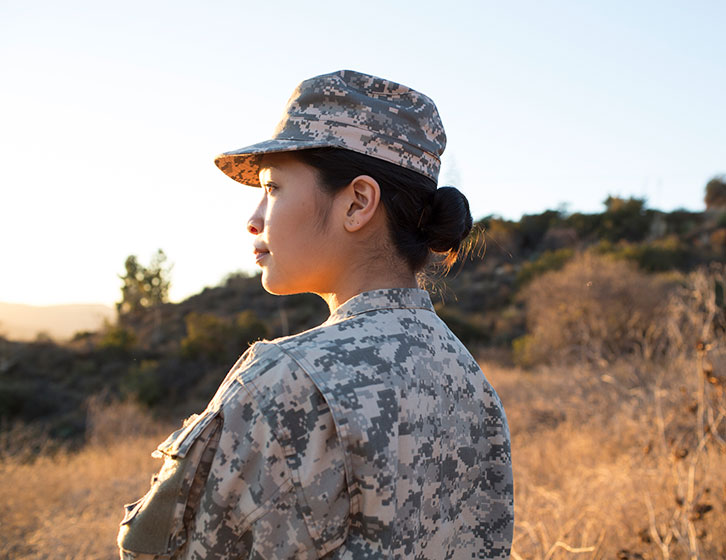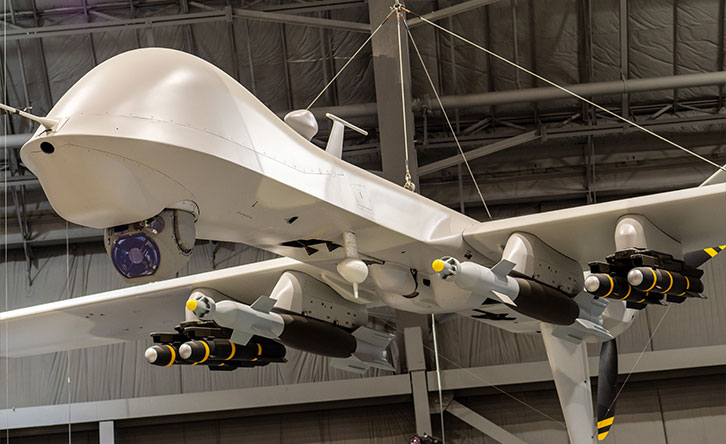Contributing Across America
Military &
National Security
Alongside Americans of every race and ethnicity, Chinese Americans have demonstrated their commitment to the nation by fighting for its security and freedom in every crucial moment in history—from the Civil War to World War II to the War on Terror. Today, as rapid technological evolution is reshaping the character of national security operations, Chinese American scientists and researchers continue to play an important role in keeping the US at the forefront of global innovation and military leadership.
1 in 40
living Chinese Americans aged 17 years old or over has served, is serving or is training in the military.
In the intelligence community, more than 15,000 Chinese Americans work on national security and international affairs in the public sector as of 2018, accounting for 1.3% of all Americans working in this field—slightly above their share in the American population. Within these operations, Chinese Americans have made outsized contribution in certain technical occupations: one in 20 computer and information research scientists and one in 40 interpreters and translators working in the intelligence community are Chinese American.
Historically, Chinese Americans have served in the American armed forces since the Civil War, although their participation was not well documented until World War II when one out of every five Chinese American men served in the US Armed Forces.
Some Chinese American servicemembers earned decorations for bravery and sacrifice. Rear Admiral Gordon Chung-Hoon, for instance, was awarded the Navy Cross and Silver Star honors for his heroism when commanding a Navy warship (the USS Sigsbee, a destroyer) in the Pacific campaign against Japan. Captain Francis B Wai, killed when leading assaults upon the enemy in the Philippines, received the Medal of Honor—the US’s highest and most prestigious military decoration for bravery. To date, he is the only Chinese American recipient of the medal and one of two non-Japanese Asian American awardees.

Several notable Chinese American women also made important contributions during World War II. For example, Hazel (Ying) Lee and Maggie Gee joined the Women Airforce Service Pilots (WASP) to work with the US Air Force to ferry planes from factories to air bases and test planes for mechanical problems. In addition, a group of Chinese American women provided translation and interpretation services under the Women’s Army Corp while others served in the Army Nursing Corps.
Since the end of World War II, Chinese Americans have continued to play a crucial role in protecting American national security interests in various capacities, including fighting in armed conflicts where necessary. As of 2018, one in 40 first-line supervisors of mechanics, installers and repairers in the US Army is Chinese American; one in 50 healthcare practitioners and technical personnel serving in the military is Chinese American.
Standouts include Colonel Geoffrey Ling, who specializes in traumatic brain injury and prostheses, two areas of medical practice that provide both veterans and active-duty servicemembers with life-changing care.

Another notable individual is Major General John L. Fugh, who introduced the Army’s first environmental law division and established its procurement fraud division. He also established a human rights training program and published the War Crimes Report—the first American effort since World War II to systematically document enemy war crimes.

Chinese American scientists and researchers are a main driving force in American development of advanced technologies—artificial intelligence, robotics, computing and neuroscience, biotechnology and implantable devices—all of which play an important role in keeping the US at the forefront of global innovation and military leadership.
Heidi Shyu, for instance, in her role as the Assistant Secretary of the Army for Acquisition, Logistics and Technology, played a central role in the US Army’s development and acquisition of new weapons technology, overseeing the complete management of the Army’s weapons systems and equipment, from research and development to testing and deployment. To similar ends, Gilman Louie served on the National Security Commission on Artificial Intelligence, reviewing advances in artificial intelligence, machine learning developments and associated emerging technologies to address national security and defense needs.
Citizens like Ms Shyu and Mr Louie, along with other Chinese American scientists and engineers, have long been a driving force for research and innovation in the US and hold the promise to make increasing contributions to American national security and military leadership.
